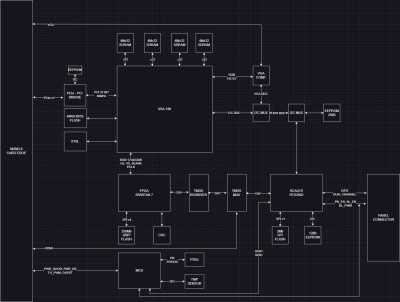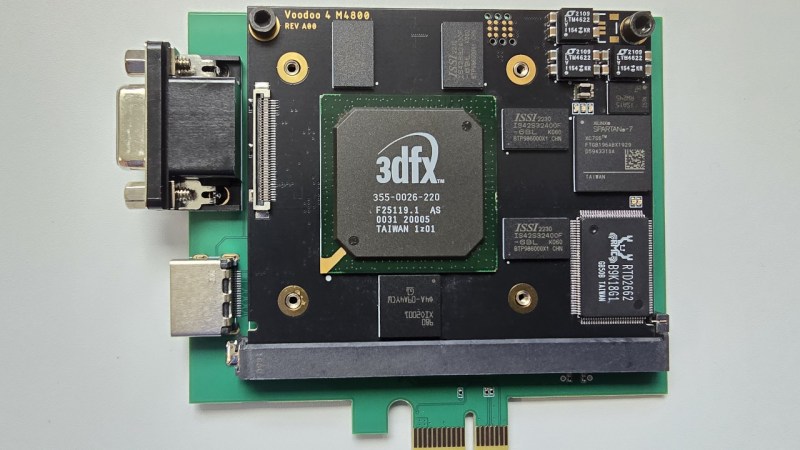[sdz] of Vogons forum brings us an unexpected device for the 21st century – a 3dfx Voodoo 4 card in MXM format, equipped with 64MB of RAM. This isn’t just a showpiece – this card actually, properly works when installed into our hacker’s Dell Precision M4800, and [sdz] tells us more on how the card came to be.
 Equipped with a VSA-100 GPU, this card has a whole lot of support components for adapting old interfaces to modern ones. There’s a PCIe-PCI bridge IC, an FPGA, HDMI muxes, and a Realtek scaler for video conversion. Handling all the MXM interfaces would’ve been downright impossible, so the card also holds an LVDS header for the M4800’s panel. Plus, for testing all of it, [sdz] has developed a PCIe to MXM adapter board with minimal circuitry needed to have the card work – this is a seriously involved hack and it’s executed remarkably well.
Equipped with a VSA-100 GPU, this card has a whole lot of support components for adapting old interfaces to modern ones. There’s a PCIe-PCI bridge IC, an FPGA, HDMI muxes, and a Realtek scaler for video conversion. Handling all the MXM interfaces would’ve been downright impossible, so the card also holds an LVDS header for the M4800’s panel. Plus, for testing all of it, [sdz] has developed a PCIe to MXM adapter board with minimal circuitry needed to have the card work – this is a seriously involved hack and it’s executed remarkably well.
The forum post shows a whole lot of the journey, from receiving the PCBs to code and FPGA gateware bringup, as well as videos of VGA and HDMI operation. In the end, our hacker shows us a fully working setup, the 3dfx card inserted into M4800 and driving its display, as well as overclocking experiments; the author has promised to open-source the card files in due time, too. It’s seriously nice to see DIY MXM cards in the wild, and if you ever wanted to build one, we’ve got an article tells you everything you could want to know about the MXM standard.
We thank [Misel] for sharing this with us!

















I don’t know why you did it but AWESOME!!!
(wasn’t us who did it, that was [sdz], but 100% agreed on the AWESOME part!)
This is pure excellence! Oh man, I need to adapt one of these into an Inspiron 9100 / inspiron XPS :D
Would be something with an “emotion engine” in a PC.
The 3dfx Voodoo era was awesome. Such massive advancements in 3D graphics for the home user, and it came with great linux support (perhaps ‘great’ is subjective, but compared to other hardware manufactures at the time…).
Although this also put more nails in SGI’s coffin.
But why a Voodoo 4 and not a 5?
Because a Voodoo 5 is just 2x Voodoo 4 on one board.
If I recall both the voodoo 4 and voodoo 5 used the vsa-100 and launched at nearly the same time. The difference was a one chip (voodoo 4 4500) vs two chip (voodoo 5 5500) solution. There has been much work to get the 4 chip solution (voodoo 5 6000) working by people who have either gotten prototypes or I believe one person rebuilt a new design fixing issues.
Why a Voodoo 4 and not a Voodoo rush?
Isn’t the point getting completely outdated hardware to work with a modern motherboard?
Voodoo rush is the first, buggy, early access version of the Voodoo 1.
Wasn’t the 1/2 passthrough design.